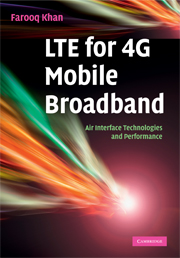Book contents
- Frontmatter
- Contents
- Preface
- 1 Introduction
- 2 Network architecture and protocols
- 3 Downlink access
- 4 Single-carrier FDMA
- 5 Reducing uplink signal peakiness
- 6 Transmit diversity
- 7 MIMO spatial multiplexing
- 8 Channel structure and bandwidths
- 9 Cell search and reference signals
- 10 Random access
- 11 Channel coding
- 12 Scheduling, link adaptation and hybrid ARQ
- 13 Power control
- 14 Uplink control signaling
- 15 Downlink control signaling
- 16 Inter-cell interference control
- 17 Single frequency network broadcast
- 18 Spatial channel model
- 19 LTE performance verification
- Index
2 - Network architecture and protocols
Published online by Cambridge University Press: 28 February 2011
- Frontmatter
- Contents
- Preface
- 1 Introduction
- 2 Network architecture and protocols
- 3 Downlink access
- 4 Single-carrier FDMA
- 5 Reducing uplink signal peakiness
- 6 Transmit diversity
- 7 MIMO spatial multiplexing
- 8 Channel structure and bandwidths
- 9 Cell search and reference signals
- 10 Random access
- 11 Channel coding
- 12 Scheduling, link adaptation and hybrid ARQ
- 13 Power control
- 14 Uplink control signaling
- 15 Downlink control signaling
- 16 Inter-cell interference control
- 17 Single frequency network broadcast
- 18 Spatial channel model
- 19 LTE performance verification
- Index
Summary
The LTE network architecture is designed with the goal of supporting packet-switched traffic with seamless mobility, quality of service (QoS) and minimal latency. A packet-switched approach allows for the supporting of all services including voice through packet connections. The result in a highly simplified flatter architecture with only two types of node namely evolved Node-B (eNB) and mobility management entity/gateway (MME/GW). This is in contrast to many more network nodes in the current hierarchical network architecture of the 3G system. One major change is that the radio network controller (RNC) is eliminated from the data path and its functions are now incorporated in eNB. Some of the benefits of a single node in the access network are reduced latency and the distribution of the RNC processing load into multiple eNBs. The elimination of the RNC in the access network was possible partly because the LTE system does not support macro-diversity or soft-handoff.
In this chapter, we discuss network architecture designs for both unicast and broadcast traffic, QoS architecture and mobility management in the access network. We also briefly discuss layer 2 structure and different logical, transport and physical channels along with their mapping.
Network architecture
All the network interfaces are based on IP protocols. The eNBs are interconnected by means of an X2 interface and to the MME/GW entity by means of an S1 interface as shown in Figure 2.1. The S1 interface supports a many-to-many relationship between MME/GW and eNBs.
- Type
- Chapter
- Information
- LTE for 4G Mobile BroadbandAir Interface Technologies and Performance, pp. 5 - 19Publisher: Cambridge University PressPrint publication year: 2009



